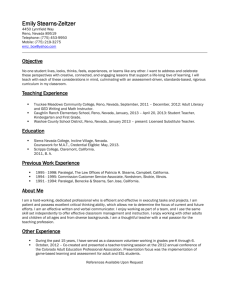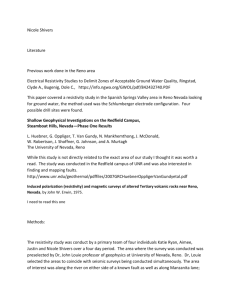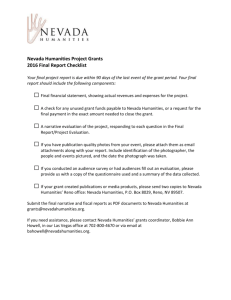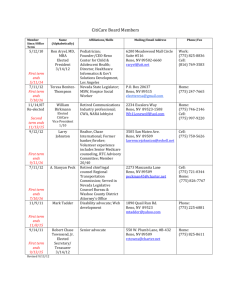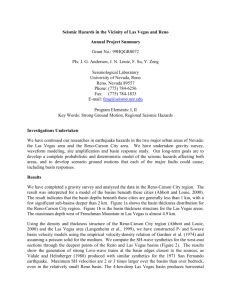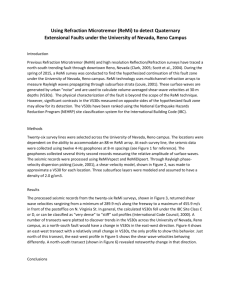The Truckee Meadows Basin Seismic Reflection Imaging Experiment
advertisement
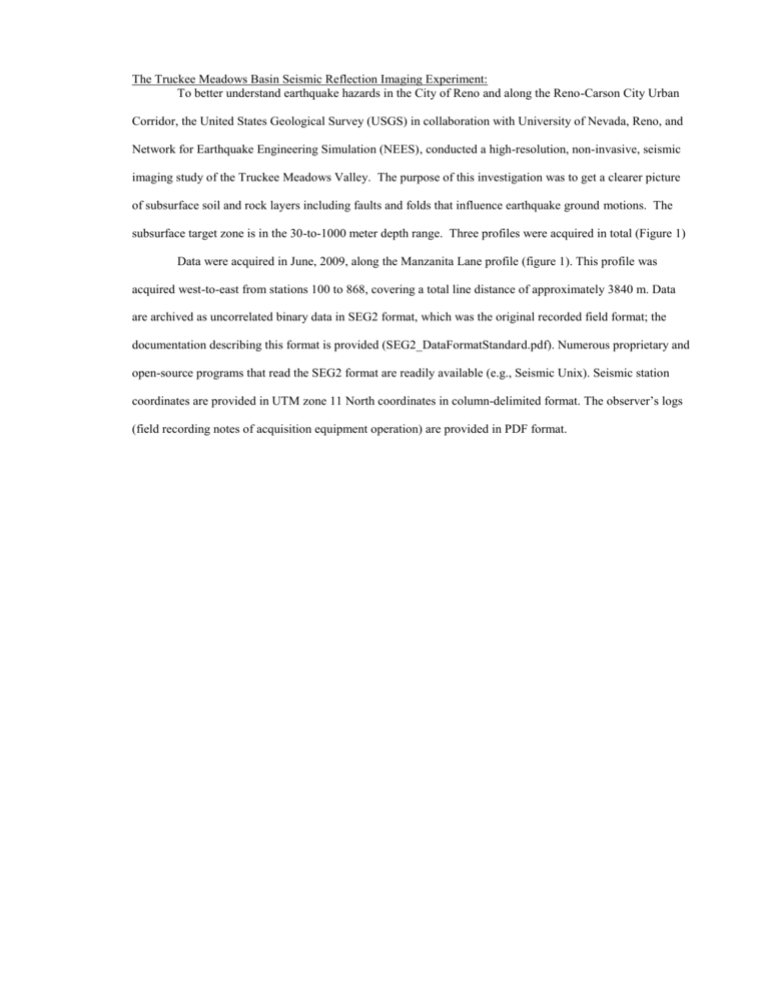
The Truckee Meadows Basin Seismic Reflection Imaging Experiment: To better understand earthquake hazards in the City of Reno and along the Reno-Carson City Urban Corridor, the United States Geological Survey (USGS) in collaboration with University of Nevada, Reno, and Network for Earthquake Engineering Simulation (NEES), conducted a high-resolution, non-invasive, seismic imaging study of the Truckee Meadows Valley. The purpose of this investigation was to get a clearer picture of subsurface soil and rock layers including faults and folds that influence earthquake ground motions. The subsurface target zone is in the 30-to-1000 meter depth range. Three profiles were acquired in total (Figure 1) Data were acquired in June, 2009, along the Manzanita Lane profile (figure 1). This profile was acquired west-to-east from stations 100 to 868, covering a total line distance of approximately 3840 m. Data are archived as uncorrelated binary data in SEG2 format, which was the original recorded field format; the documentation describing this format is provided (SEG2_DataFormatStandard.pdf). Numerous proprietary and open-source programs that read the SEG2 format are readily available (e.g., Seismic Unix). Seismic station coordinates are provided in UTM zone 11 North coordinates in column-delimited format. The observer’s logs (field recording notes of acquisition equipment operation) are provided in PDF format. Figure 1. Map of the Reno metropolitan area, showing generalized geology (Stewart and Carlson, 1978). Geologic units are: JTRsv-late Triassic to early Cretaceous sedimentary and volcanic deposits; Kgr-Cretaceous granitic rocks; Tri-Eocene to Miocene rhyolitic intrusive rocks; Ts3-late Eocene to late Miocene tuff aceous sedimentary rocks; Ta3-late to middle Miocene andesitic rocks; Tba-early Miocene to early Pliocene andesitic and basaltic flows; QTb-Miocene to Quaternary basalt flows; QaQuaternary alluvial deposits. The dark blue lines are recent faults (Sawyer, 1999) and the red lines are the mini vibroseis seismic reflection profiles. Purple box is the area of Figure 2. This figure and caption are excerpted from Master’s Thesis of R. Frary, 2012, University of Nevada Reno. Figure 2. Map of the Manzanita Lane area profiles. Area corresponds to purple outline in Figure 2.2. Geologic units are: Ts3-late Eocene to late Miocene tuff aceous sedimentary rocks; Ta3-late to middle Miocene andesitic rocks; Qa-Quaternary alluvial deposits (Stewart and Carlson, 1978). The dark blue lines are recent faults (Sawyer, 1999), red lines are the minivib seismic reflection profiles. Numbers are shot points along the minivib (Thumper) profile. Arrow indicates important fault in this area. This figure and caption are excerpted from Master’s Thesis of R. Frary, 2012, University of Nevada Reno. References: Frary, R. N., 2012, Fault Imaging with High-Resolution Seismic Reflection for Earthquake Hazard and Geothermal Resource Assessment in Reno, Nevada, M.Sc. Thesis, University of Nevada, Reno, 51 p. Sawyer, T. L., 1999, compiled Mount Rose fault zone in Fault and Fold Database of the United States: earthquake.usgs.gov/hazards/qfaults. Stewart, J. H., and J. E. Carlson, 1978, Geological map of Nevada 1:500,000: U.S. Geological Survey and Nevada Bureau of Mines and Geology.
